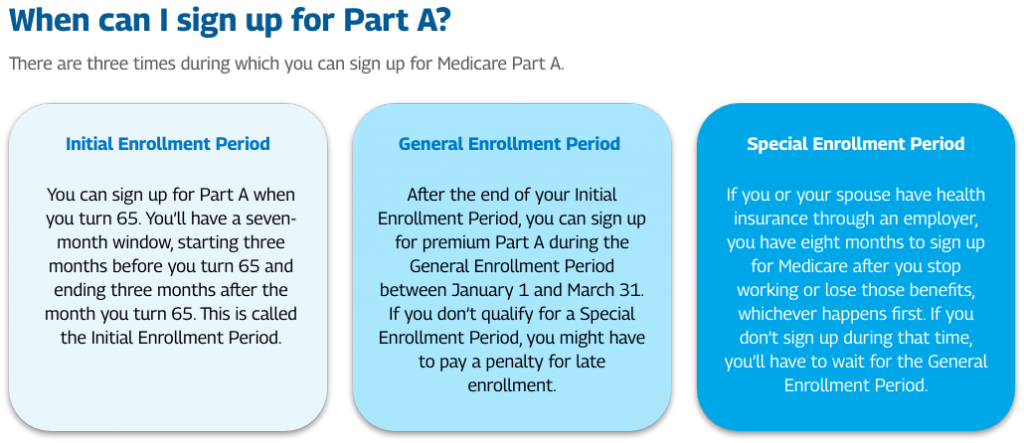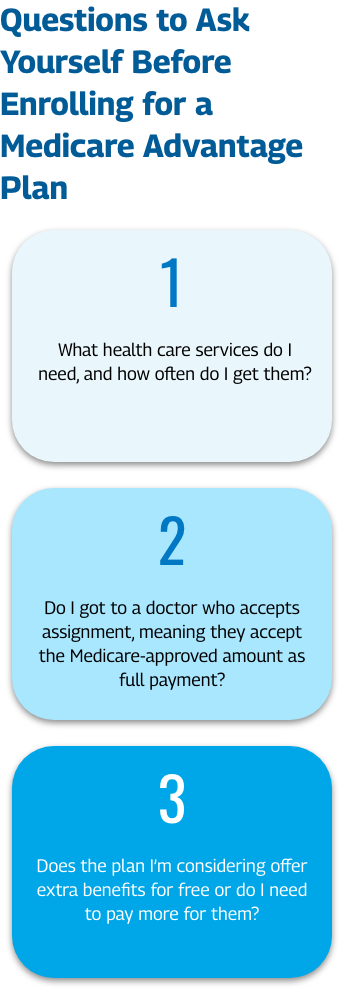Whether you’re on Medicare, are looking to enroll or are a caregiver to a Medicare patient, the list of different plans and options can be confusing to navigate.
What coverage do you need? What are the costs? Do you have any options or is Medicare a one-size-fits-all program? Is there anything that needs to be done prior to looking into plans?
We’ve created this guide to help seniors and caregivers have a better understanding of each and every part to help you make the best decision regarding you or a loved one’s health.
Table of contents:
What to do before choosing a plan
Before choosing a plan, our team of experts highly recommends finding a doctor that aligns with your needs and preferences. This way, you’ll avoid being limited to providers in your area that only accept certain Medicare plans.
You can find a new primary care provider that accepts Medicare and specializes in senior care near you by using our free Find Your Doctor tool to search for and compare value-based care providers and care clinics near you.
All of our provider partners practice value-based care, meaning Medicare rewards them for helping their patients get better. With a value-based care provider, you can expect quicker appointment scheduling, shorter waits at the doctor’s office and a meaningful connection with your physician.
Once you find a new primary care provider that checks all of your important boxes, it’s time to look into which Medicare plan can accommodate your health needs and budget. We’re here to help!
What is Medicare Part A?
Medicare Part A, often referred to as Original Medicare when combined with Part B, pays for inpatient care at a hospital or a skilled nursing facility, as well as hospice and home care.
Most people on Part A don’t pay a premium, but there are some out-of-pocket expenses, including a deductible and coinsurance.
When paired with Part B as Original Medicare, Part B pays for doctor visits, tests and some medical supplies.
What does Medicare Part A cover?
Medicare Part A covers inpatient medical care, including:
- Hospital inpatient care
- Mental health inpatient care
- Skilled nursing facility care
- Hospice care
- Home care


Under Part A, you can choose any doctor, health care provider, hospital or facility that is enrolled in Medicare and is taking new patients. Generally, you don’t need a referral to see a specialist.
However, it is important to note that Part A DOES NOT cover:
- Regular doctor visits with your primary care provider
- Screenings
- Preventative care
- Long-term care
- Or most dental, hearing and vision care
- Or most prescription drugs except for those to relieve pain or control symptoms in hospice patients
What does Medicare Part A cost?
Part A Premiums
The good news is most people can get Medicare at age 65 without a premium. However, if you don’t qualify for premium-free Part A, you can buy coverage for a monthly premium of $274 or $499 in 2022. The cost of the premium depends on how long you or your spouse worked and paid Medicare taxes.
If you have to pay the premium but don’t enroll in Part A when you’re first eligible, your premium may go up 10 percent.
Deductible and coinsurance
While most people can get Part A without a premium, they still have to pay a deductible and coinsurance costs.
For example, the out-of-pocket costs per benefit period for an inpatient hospital stay under Part A are:
- $1,556 deductible
- Days 1-60: $0 coinsurance
- Days 61-90: $389 coinsurance per day
- Days 91 and beyond: $778 coinsurance per each lifetime reserve day after day 90. (You have up to 60 lifetime reserve days)
- Beyond lifetime reserve days: All costs
Is everyone automatically enrolled in Medicare Part A?
You’ll be automatically enrolled when you apply for retirement or disability benefits from Social Security or the Railroad Retirement Board. Your Part A coverage will start once your application is approved and you are eligible for Medicare.
If you’ve been getting Social Security or Railroad Retirement Board benefits for at least four months, you’ll automatically get Part A when you turn 65 and won’t have to pay a premium for Part A in either scenario.
If you haven’t applied for Social Security or Railroad Retirement Board benefits, you’ll have to take specific steps to enroll in Part A.


What is Medicare Part B?
Medicare Part B is medical insurance that pays for doctor visits, screenings and other outpatient services and supplies. You’ll pay a monthly premium and have a deductible and coinsurance payments.
What does Medicare Part B cover?
Medicare Part B covers two types of services: Medically necessary services and preventative services, including:
- Doctor visits
- Diagnostic screening
- Durable medical equipment such as:
- Wheelchairs
- Oxygen equipment
- Crutches
- Blood testing strips for diabetics
Part B DOES NOT cover:
- Hospital inpatient care (Covered by Part A)
- Skilled nursing care (Covered by Part A)
- Hospice care (Covered by Part A)
- Home care (Covered by Part A)
- Most prescription drugs
- Most vision, hearing and dental care
What does Medicare Part B cost?
Unlike Medicare Part A, with Medicare Part B, you’ll pay a monthly premium and have a yearly deductible and coinsurance payments no matter your coverage.
Part B Premiums
The standard Part B premium is $170.10 a month as of 2022, but you’ll pay more if your annual income exceeds $91,000 (individual) or $182,000 (joint). If you don’t sign up for Part B when you’re first eligible, you could also pay a higher premium as a penalty.
Part B deductible and coinsurance
The annual Part B deductible is $233. After meeting the deductible, you typically will pay 20 percent of the Medicare-approved amount for most doctor services, outpatient therapy and durable medical equipment.
You pay nothing for home care services, clinical laboratory services and most preventative services like vaccines, wellness visits and screenings related to mental health, cancer and other health conditions.
Is everyone automatically enrolled in Medicare Part B?
You’ll automatically get Part B when you turn 65 if you’ve been getting Social Security or Railroad Retirement Board benefits for at least four months. You can drop this coverage when you get your Welcome to Medicare package.
If you haven’t applied for Social Security or Railroad Retirement Board benefits, you’ll have to take specific steps to enroll in Part B.
How do I sign up for Medicare part B?
If you aren’t applying for retirement benefits, but still want Part B, you can sign up through Social Security online at www.ssa.gov/benefits/medicare or by calling 1-800-772-1213.
If you or your spouse worked for a railroad, you’ll need to call the Railroad Retirement Board at 1-877-772-5772 to apply for Part B.
You can also sign up for Part B online, which typically only takes 10 minutes to apply with no forms needed to complete the application, and you usually don’t need documentation.
What’s the difference between Medicare Part A and Medicare Part B?
Part A and Part B combined are referred to as Original Medicare; BUT it’s important to remember that they do not provide the same types of coverage.
Part A, also known as “hospital insurance,” covers inpatient care, while Part B covers outpatient care. Combining Parts A and B will provide you with the more coverage than just enrolling for one part.
If you’re looking for prescription coverage, you’ll want to look into Medicare Part C and Part D, as Original Medicare does not do so.
What is Medicare Part C?
Medicare Part C plans, often referred to as Medicare Advantage plans, cover the same medically necessary services covered by Original Medicare (Plans A and B) plus additional coverage. Part C comprises Medicare-approved insurance plans sold by private companies. It is a great option for those who need more than just potential inpatient services or routine doctor visits.
What does Medicare Part C cover?
Medicare Part C not only covers the same services covered by Plan A and Plan B, but also may include extras like:
- Dental
- Hearing
- Vision care
- Prescription drug coverage
- Fitness programs and transportation services
With such a variety of coverage, that’s why you often see the terms “all-in-one” or “bundled” in descriptions of Part C plans.


What does Medicare Part C cost?
Part C plans vary depending on the specific plan and your state. Plans vary in terms of premiums, deductibles, coinsurance and copayments.
Keep this in mind: If you decide to enroll for a Part C plan, you might have to pay two premiums. You’ll pay the Part C premium and the monthly Part B premium.
The standard Part B premium is $170.10 a month in 2022, but it’s higher if your annual income exceeds $91,000 (individual) or $182,000 (joint).
Part B premium relief
To ease the burden of paying two premiums, some Medicare Advantage plans have a $0 premium. Other plans pay all or part of your Part B premium in what is commonly called a Medicare Giveback.
Out-of-pocket caps
Medicare Advantage plans cap annual out-of-pocket costs for Part A and Part B services. After that, you pay nothing. Each plan has a different cap, but Medicare set the 2022 absolute ceiling at $7,550 for in-network services and $11,300 for combined in-network and out-of-network services.
Is Medicare Part C my best option?
It all depends on what is best for you! If you feel Original Medicare doesn’t provide enough coverage for your lifestyle and needs, then a Medicare Advantage plan might be the best option for you or a loved one.
Before committing to Plan C, it’s important to ask yourself a few important questions regarding your health.


How do I find a Medicare Advantage Plan?
You can find and compare Medicare Advantage plans in your area by using Medicare’s Plan Finder.
You also can find Advantage Plans by searching the websites of insurance companies that provide them.
How do I sign up for Medicare Part C?
After you do your research and select a Medicare Advantage Plan, you can enroll in one of several ways:
- Use the Plan Finder at Medicare.gov
- Use the insurance plan’s website
- Call the plan and ask to enroll
- Call Medicare at 1-800-MEDICARE
- Contact the plan and ask for a paper enrollment form
What is Medicare Part D?
Medicare Part A and Part B don’t cover most prescription drugs. So, if you choose Original Medicare, you might want to get a Part D plan to help pay for medication.
Like Part C, Part D includes Medicare-approved plans from private insurance companies.
Part D plans vary by what they charge in premiums, deductibles, copayments and coinsurance, and by their formularies, the lists of brand-name and generic drugs they cover.
Remember, most Medicare Advantage plans already cover prescription drugs and won’t allow you to join a Part D plan.
What does Medicare Part D cover?
Part D covers most outpatient drugs. Each plan has a formulary or list of drugs it covers. Per Medicare rules, each formulary must include at least two drugs in the most prescribed categories and classes. Individual plans decide which drugs to include, and your plan can change its formulary at any time, which may affect the cost of your medications.
Mandatory coverage
Part D plans must cover all available drugs in the following categories:
- HIV/AIDS drugs
- Antidepressants
- Antipsychotics
- Anticonvulsants
- Immunosuppressant drugs
- Anticancer drugs (unless covered by Part B)
Plan D DOES NOT cover:
- Over-the-counter medications
- Erectile disfunction
- Anorexia/anti-obesity
- Fertility
- Cosmetic
- Cough and cold
- Vitamins and minerals
Also, some medications aren’t covered by Part D because they’re under Part B, such as infusion cancer drugs.
What does Medicare Part D cost?
Premiums
Most Part D plans have a monthly premium. The amount varies by plan and can be deducted from your Social Security payment.
If you make more than $91,000 (separate) or $182,000 (joint) in a year, you’ll have to pay more than your plan’s standard premium. The extra monthly fees are assessed by income brackets and range from $12.40 to $77.90.
Enrolling late in Part D coverage can raise your premium.
Deductible
Some plans make you meet a deductible before they start to pay for your medication. Other plans don’t. The deductible amount can vary from plan to plan, but the most you’ll have to pay in 2022 is $480.
Copayment/Coinsurance cost
The copayment or coinsurance is what you pay out-of-pocket after the plan has paid its share of your prescription. A copayment is a set amount, like $20 per prescription. Coinsurance is a percentage, such as 20 percent of the prescription cost.
What you pay in copayments or coinsurance often depends on the drug’s tier—the higher the tier, the higher your cost.
Learn more about the costs associated with Plan D.
Is Medicare Part D required?
No, you do not need to be enrolled in Medicare Part D. If you have drug coverage from a different provider that Medicare deems creditable, then there is no need to sign up for a Part D plan. However, if you do not have any sort of drug coverage plan, then you will be wholly responsible for the costs of your medications.
Where do I find Medicare Part D plans?
You can find and compare Medicare drug plans with the Medicare Plan Finder.
Once you find a Part D plan you like, there are several ways you can enroll:
- Medicare Plan Finder or the plan’s website
- Paper enrollment form
- Calling the plan
- Calling Medicare at 1-800-633-4227
Make sure to have your Medicare card when you sign up to make things go smoother and quicker.
What is the difference between Medicare Part C and Medicare Part D?
Part D comprises supplemental insurance plans that only cover prescription drug costs, while Part C plans are an alternative to Original Medicare and include hospitalization and medical insurance, along with other benefits.
Part C plans that cover prescription drugs often won’t allow you to enroll in a Part D plan at the same time. Doing so could result in you being switched to Original Medicare.
Where can I find more information on Medicare and Medicare physicians?
At NewPrimaryCare.com, we’re dedicated to helping seniors find the value-based primary care they deserve all while accepting their chosen Medicare plan.
Our website contains a learning resource center that is continuously updated with articles to give you the tools needed to make better decisions when it comes to choosing a Medicare doctor or physician and staying heathy as you age.


